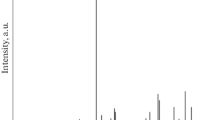Abstract
We have determined the composition range of solid solutions in the binary system YPO4-YbPO4 and identified the key trends in the composition dependence of their IR Stokes luminescence intensity and decay time in the range 0.96–1.1 μm. The results were used to develop a new narrow-band IR phosphor, YPO4:Yb3+. Under 0.940-μm laser excitation, this phosphor offers an increased IR Stokes luminescence intensity in the range 0.96–1.1 μm (about twice as high as that of the well-known commercially available phosphors L-54 and FSD-546-2), with an afterglow time of 1700–1800 μs.
Similar content being viewed by others
References
Georgobiani, A.N., Gutan, V.B., and Manashirov, O.Ya., Synthesis and Laser-Excited IR Luminescence of Ln2O2S:Yb with Ln = Y, La, and Gd, Kratk. Soobshch. Fiz., 2010, no. 10, pp. 14–22.
Boulon, G., Why So Deep Research on Yb3+-Doped Optical Inorganic Materials?, J. Alloys Compd., 2008, vol. 451, pp. 1–11.
Yoshikawa, A., Boulon, G., Laversenne, L., et al., Growth and Spectroscopic Analysis of Y3Al5O12 Fiber Single Crystals, J. Appl. Phys., 2003, vol. 94, no. 9, pp. 5479–5488.
Bensalah, A., Guyot, Y., Brenier, A., et al., Spectroscopic Properties of Yb3+:LuLiF4 Crystal Grown by the Czochralski Method for Laser Applications and Evaluation of Quenching Processes: A Comparison with Yb3+:YLiF4, J. Alloys Compd., 2004, vol. 380, pp. 15–26.
Boulon, G. Laversenne, L., et al., Radiative and Non-Radiative Energy Transfers in Yb3+-Doped Sesquioxide and Garnet Laser Crystals from Combinatorial Approach Based in Gradient Concentration Fibers, J. Lumin., 2003, vols. 102–103, pp. 417–425.
Zhang, L. and Hu, H., Evaluation of Spectroscopic Properties of Yb3+ in Tetraphosphate Glass, J. Non-Cryst. Solids, 2001, vol. 292, pp. 108–114.
Dexter, D.L. and Schulman, J.H., Theory of Concentration Quenching in Inorganic Phosphors, J. Chem. Phys., 1954, vol. 22, no. 6, pp. 1063–1070.
Poluektov, M.S., Efryushina, N.P., and Gava, S.A., Opredelenie mikrokolichestv lantanoidov po lyuminestsentsii kristallofosforov (Trace Analysis of Lanthanides from Luminescence of Crystalline Phosphors), Kiev: Naukova Dumka, 1976.
Belovolov, A.M., Belovolov, M.I., Dianov, E.M., et al., An Experimental Study of Energy Transfer Processes in Gadolinium Gallium Garnet Crystals Activated with Ho3+ and Yb3+, Preprint of Inst. of General Physics, Russ. Acad. Sci., Moscow, 2006, no. 11.
Author information
Authors and Affiliations
Corresponding author
Additional information
Original Russian Text © O.Ya. Manashirov, A.N. Georgobiani, V.B. Gutan, E.M. Zvereva, A.N. Lobanov, 2011, published in Neorganicheskie Materialy, 2011, Vol. 47, No. 12, pp. 1514–1520.
Rights and permissions
About this article
Cite this article
Manashirov, O.Y., Georgobiani, A.N., Gutan, V.B. et al. Synthesis and laser-excited IR luminescence of Y1 − x Yb x PO4 solid solutions. Inorg Mater 47, 1384–1390 (2011). https://doi.org/10.1134/S0020168511110124
Received:
Published:
Issue Date:
DOI: https://doi.org/10.1134/S0020168511110124




